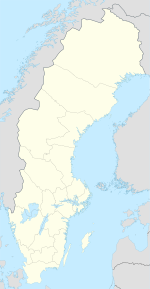The King's Grave
 Kiviksgrave burial site near Kivik, Sweden | |
| Location | Scania, Sweden |
|---|---|
| Coordinates | 55°41′N 14°14′E / 55.683°N 14.233°E |
| Site notes | |
| Condition | In ruins |
The King's Grave (Kungagraven i Kivik, Kiviksgraven) is an archaeological site. It is situated near Kivik in the southeastern portion of Scania, Sweden. The site is what remains of an unusually grand Nordic Bronze Age double burial dating from circa the 15th century BC.[1][2] [3]
Site
[edit]The site is located about 320 metres (1,000 ft) from the shore of the eastern coast of Scania. These two burials are unique. In both construction and in size—it is a circular site measuring 75 metres (250 ft) in diameter—this tomb differs from most European burials from the Bronze Age. Most importantly, the cists are adorned with petroglyphs. The images carved into the stones depict people, animals (including birds and fish), ships, lurs being played, symbols and a chariot drawn by two horses and having four-spoked wheels.[4]
History
[edit]
The site was used as a quarry for construction materials until 1748, when two farmers discovered a 3.25 metres (11 ft) tomb, with a north–south orientation, constructed with ten slabs of stone. Still, the quarrying continued and some of the stones disappeared. In 1756 the site was analyzed by antiquarian and archaeologist Nils Wessman (1712–1763). Wessman had undertaken extensive trips to Scania in the 1740s and 1750s for archaeological investigations.[5]
The site was excavated by archaeologist Gustaf Hallström (1880–1962) starting in 1931. From 1925 until his retirement in 1945, Hallström worked as an antiquarian at the Swedish National Heritage Board (Riksantikvarieämbetet). Between 1931 and 1933, a thorough excavation was undertaken and the remains of a Stone Age settlement was found under the massive cairn, including a great deal of flintstone shards. Only teeth, fragments of bronze, and some pieces of bone were found, dating from the Bronze Age.[6] [7]
The mound contained two cists. On the left side of the cist's southern end, there were raised slabs of stone from a 1.2 metres (3.9 ft) long and 0.65 metres (2.1 ft) wide cist. It was named the King's Grave due to its size, long before it was known to contain two burials. Since the site has been subject to numerous lootings, there are no reliable finds, but it is believed that the two graves were built at the same time.[citation needed]
After the excavation, the tomb was restored, but no one knows whether it looks similar to its original state. A comparison with other contemporaneous graves suggests that the site might have been three times higher than the 3.5 metres (11 ft) as restored. The restoration was based on etchings from the 18th century and conjecture. A new chamber was constructed out of concrete and a tunnel extended into the cists. Today, it is possible for visitors to the site to enter the tomb and to see the engraved stones.[8]
Gallery
[edit]-
Aerial view of the Kivik grave
-
One of ten slabs of stone shows a horse drawn chariot with two four-spoked wheels
-
One of the slabs of stone shows people (eight in long robes)
-
The stones of the grave facing the grave of Kivik
-
Stones within the cairn of Kivik
-
Stones within the cairn of Kivik
-
Drawings of one of the petroglyph slabs within the grave (see: Golden hats)
See also
[edit]References
[edit]- ^ Kristiansen, Kristian; Larsson, Thomas B. (2005). The rise of Bronze Age society. Cambridge University Press. p. 193. ISBN 9780521843638.
- ^ Bredarör i Kivik (Joakim Goldhahn, Department of Archaeology, University of Gothenburg)
- ^ "Kiviksgraven". kiviksgraven.se. Retrieved December 1, 2019.
- ^ "Kiviksgraven". Statens fastighetsverk. Retrieved December 1, 2019.
- ^ "Kiviksgraven – Sveriges största bronsåldersgrav" (PDF). Riksantikvarieämbetet. Retrieved December 1, 2019.
- ^ "Gustaf A Hallström". Svenskt biografiskt lexikon. Retrieved December 1, 2019.
- ^ Gustaf Hallströms arkiv (Research Archives, Umeå University) Archived 2010-06-02 at the Wayback Machine
- ^ "Kiviksgraven (Kungagraven)". sydsverige.dk. Retrieved December 1, 2019.
Other sources
[edit]- Baudou, Evert Gustaf Hallström: arkeolog i världskrigens epok (Stockholm: Natur & Kultur. 1997)








